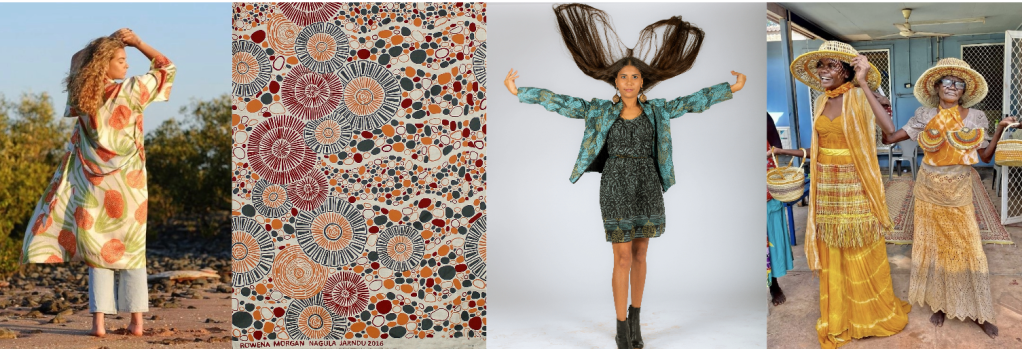2023 has marked a national and international success trajectory for Australian First Nations fashion. The year began with the historic First Nations designers showcase at London Fashion Week.
In May, First Nations designers showcased collections at Australian Fashion Week to much acclaim. And, for the first time in the event’s history, stand-alone First Nations collections were showcased by the Ngali label and by Ikuntji Artists. Ikuntji is a remote Aboriginal art centre located in the Haasts Bluff community in Central Australia.
The trajectory continued. The Country to Couture runway, attached to the Darwin Aboriginal Art Fair’s Indigenous Fashion Projects, showcased a record 22 collections from art centres and creatives across Australia.
What new and innovative collections are being created in art centre studios across remote Australia to wow next year’s audiences? What does this mean for the art centres recreating cultural stories in textiles and fashion? And how can the fashion industry benefit creatives from remote Australia and ensure the agency of cultural practice and decision-making?
ArtsHub raises these questions with National Indigenous Fashion Awards (NIFA) recipients to understand some of the benefits and challenges.
Ethical practice
Rowena Morgan, a Gija-Gooniyandi woman, won the 2023 NIFA Textile Design Award in recognition of her eight years of hand block and screen-print art practice. Morgan applies her skills and cultural knowledge to developing textile designs at Nagula Jarndu – an art centre collective based in Broome, Western Australia. The NIFA recognition will benefit Morgan with a professional development mentorship from the RMIT School of Fashion and Textiles.
‘It will be more than that,’ adds Eunice Yu, a Yawuru-Bunuba woman and the Nagula Jarndu manager of almost seven years. ‘This win made everyone happy – all the women. There was a buzz, and everyone realised that we were on track. It reconfirmed our values and our practices.’
Yu explains that Nagula Jarndu is a Yarawu collective focused on women’s well-being. ‘We have a particular way of working. We practise mabu liyan – good heart, good feelings and respectful ways.
‘We describe ourselves as “slow fashion”. We need to go slowly. We need to know everything about the process and ensure we make ethical decisions.’
Yu continues: ‘In the last few years, we have been supporting artists with their design developments. Artists create designs and block print on-site. We also collaborate with commercial screen printers and digital printers to produce our fabrics. We partner with commercial makers to produce fashion garments and other products.’
Yu is proud of the successes Nagula Jarndu has achieved. Reaching out to support others, Nagula Jarndu now auspices the Skutta initiative, a Kimberley showcase and fashion development project that will support remote Western Australia creatives.
‘Fashion and textiles are an opportunity to share artists’ stories in a way that is appealing to the marketplace,’ explains Yu. ‘Textiles are colourful, and the artists’ designs are an easy way to connect with a broad marketplace. At the same time, we need to stay true to our principles. Our ethics are essential.’
Ensuring ethical best practices is something that Indigenous Fashion Projects (IFP) has been set up to guide. As a key project of the Darwin Aboriginal Art Fair Foundation, IFP facilitates Country to Couture, the National Indigenous Fashion Awards and the Pathways Program. The intent is to safeguard First Nations’ interests and broker learning opportunities. In partnership with IP Australia and Arts Law, IFP develops tools and information to support individual creatives, art centres and industry collaborations to create culturally sound economic opportunities.
Wearable art
Gapuwiyak Culture and Arts won two NIFAs in 2023 – the Traditional Adornment Award and the Community Collaboration Award in partnership with fibre artist, Aly de Groot.
The day ArtsHub speaks with Gapuwiyak’s manager, Trevor van Weeren, he is partway through an application to Creative Australia for the Flourish – First Nations Textile and Fashion Innovation Fund. The fund invests in economic, cultural and social development opportunities in the textiles and fashion sector.
Fashion success has taken Gapuwiyak by surprise. The organisation’s initial engagement began with workshops inspired by 1930s photographs from the Donald Thompson collection. Artists developed bush-dyed fabrics and fibre art accessories in response to these images.
Van Weeren animatedly describes the excitement generated by the project, using the material culture of earlier times to recreate fibre works and modelling for photographs. ‘We set up photoshoots to reflect the original images. Modelling generated much energy. Younger community members were excited by that aspect of the project.’
In a confluence of serendipitous energies, an ABC Back Roads episode planned a focus on Gapuwiyak. The episode included filming a community runway show of its wearable art collection. Van Weeren hopes the release of the Back Roads episode in early 2024 will build on the NIFA win and enhance Gapuwiyak’s reputation among broad audiences.
‘The NIFAs have made everyone proud,’ he says, and proceeds to acknowledge, ‘there has been a definite reinvigoration of fibre art practice that has improved product quality. Younger community members who have been recognised for their modelling ability realise they can pursue this.’
He adds, ‘The recognition generated by the NIFAs has expanded the aspirations of artists and community. Artists can see new opportunities on the horizon.’
Van Weeren is hopeful the awards will eventually translate into a greater appreciation of women’s fibre art and increased income for the art centre. ‘We need to capitalise on the success to ensure our fibre artists with invaluable cultural lineage are more valued. Fibre art needs critical acclaim and a justifiable rise in the value of the practice,’ he says.
It is unclear in what direction fashion will take the art centre, but van Weeren hints that Gapuwiyak may be best to pursue a wearable art collection created in the community, rather than navigate the challenges of a commercial range. The fashion industry is a complex landscape of new learning, and Gapuwiyak is very remote with limited resources.
The grant to which he must return to at the end of his discussion with ArtsHub will seek investment to facilitate fibre art and fashion developments. In the budget detail, he must account for the tyranny of distance with the high costs of remote access for supplies and workshop delivery.
Economic outcomes for remote communities
In her policy research paper, ‘Targeted investment to grow a dynamic and sustainable First Nations fashion sector‘, Belinda Cook, a 2016 Churchill Fellow, says, ‘The First Nations fashion sector has seen exponential growth in recent years, employing First Nations people from urban centres to the most remote communities of Australia. It is a multifaceted industry with the potential for extensive and sustained cultural, social and economic outcomes. To grow sustainably requires a coordinated approach that effectively resources and meets the needs of First Nations fashion creators and businesses at each stage of the fashion and textile supply chain.’
She argues that the First Nations fashion industry could develop into a multimillion-dollar industry. She believes it has serious potential for initiatives to meet Closing the Gap targets.
The fashion sector is multifaceted, with opportunities for designers, makers, presenters and businesses. Initiatives could realise beneficial social, cultural and economic outcomes generating employment in remote communities. However, there are many challenges in maintaining the trajectory of possibility. Benefits for remote communities can only be achieved if appropriate resourcing, skills development and adequate investment are available.
As Cook indicates in her report, ‘… critical First Nations fashion programs and organisations, presenting one of the most marketable exports for Australia in recent years, largely exist on short-term and sporadic government support and high-risk commercial partnerships’.
Cook is passionate about redressing this issue to meet the needs of First Nations artists and art centres. Her report targeted government and effectively contributed to Creative Australia’s Flourish investment fund commitment. She has a good understanding of remote communities – the benefits communities offer and the support they require.
In a previous role as an art centre manager, she steered the Mangkaja x Gorman collaboration alongside senior artists and cultural advisers. The partnership took over three years to align cultural protocols and establish satisfactory agreements.
Read: Starter’s guide to fashion contracts
Cook explains some critical challenges for industry partnerships. ‘The industry needs collaborations that ensure mutually beneficial and respectful partnerships. It is important to prevent miscommunication, misunderstanding and ignorance of the value of Indigenous knowledge and creativity.
‘Communities have a different set of values to the mainstream fashion industry. We were fortunate with the Gorman partnership. They were willing to listen to the community and slow everything down to get it right. Giving agency to cultural protocols and respectfully acknowledging First Peoples’ ways of operating is critical.’
In her current role, which involves working on best practice protocols for Indigenous art and fashion, Cook contributes to IFP to build an understanding of how First Nations artists and designers want to work with the fashion industry. The IFP project will develop a toolkit of resources and education programs to promote and facilitate best practices.
Passing on cultural knowledge
Senior Waringarri artist and Miriwoong cultural custodian, Peggy Griffiths won the inaugural NIFA for Cultural Adornment and Wearable Art in 2020. For Griffiths, best practice is to ensure the next generations are strong in culture.
She mentors her daughters and granddaughters to pass on cultural stories and encourage their art practice. The younger artists have mastered textile block printing techniques to produce beautiful hand-printed designs inspired by bush plant knowledge. Encouraged by their grandmother’s award, the artists collaborated on a sample range for the 2021 Country to Couture.
Developing the sample range into a commercial collection was a two-year journey of many challenges.
‘It has been a huge undertaking,’ acknowledges manager Leana Collier. ‘Fashion is a challenging industry with many moving parts. There have been several roadblocks to work through to ensure artists are satisfied. Some are related to being remote, some are cultural concerns, and some relate to our limited understanding of the processes for creating and marketing a commercial range. As an art centre, we have been learning a whole new industry.’
In the fashion trajectory of 2023, Waringarri’s Boonkaj Collection was finally launched. Younger community members strutted runways across the Kimberley, proud of themselves and the designs they were showcasing.
‘It makes me proud knowing that our textile printing could achieve the next step of a fashion collection,’ says Waringarri Chairperson Dora Griffiths, a Miriwoong-Ngarinyman woman, daughter of Peggy Griffiths, and an accomplished textile artist herself.
She understands there have been challenges. ‘We didn’t realise how much work we needed to do. But the best bits were showing everyone what we can do – seeing our young people modelling and showcasing our designs. Seeing our designs and garments look so good on the catwalks brought us a lot of happiness.’
A trajectory of benefits
While there are many challenges in engaging with the fashion sector, remote communities also have a considerable appetite to develop capability in the space. Economic and employment opportunities are apparent for remote community artists, designers, textile printers, makers, models and photographers.
There are enduring cultural stories to inspire creation. There is growing enthusiasm in national and international markets, and the social and cultural well-being outcomes for remote communities are apparent.
However, remote communities may be vulnerable unless the industry can establish transparent commercial dealings with frameworks of ethical practice.

Advocacy for sector investment and resourcing that recognises and respects the agency and unique contribution of First Nations creators is essential to achieving sustainable successes.
As cultural custodians of the significant stories that artists and designers share, their stewardship of all aspects of design development and production is essential. It may change the pace; it may contribute to new and improved industry frameworks.
It will be slow fashion, connected to culture, inspired by profound storytelling and ethical in practice. With respect for artists’ agency, it can be a narrative to realign fashion values and create sustainable remote futures.
While there is much to navigate, there is a trajectory of benefits to be realised.
This article is published under the Amplify Collective, an initiative supported by The Walkley Foundation and made possible through funding from the Meta Australian News Fund.






